Ditapis dengan

Ultimate Heat Sink and Directly Associated Heat Transport Systems for Nuclear…
This book consist : Introduction; Design principles; Postulated initiating events; and Design features. (Jml)
- Edisi
- -
- ISBN/ISSN
- 920123581X
- Deskripsi Fisik
- 62 p. : Illus. ; 24 cm
- Judul Seri
- Safety Series No. 50-SG-D6
- No. Panggil
- -
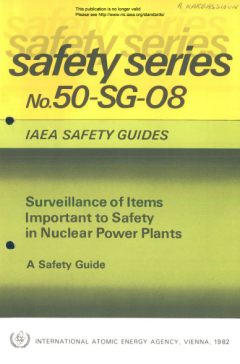
Safety Series No.50-SG-08.Surveillance of items Importment to Safety in Nucle…
This Safety Guide provides guidance and recom m endations on surveillance activities to ensure that structures, systems and com ponents im portant to safety are available to perform their functions in accordance w ith design intent and assumptions. The Guide was prepared as part of the IAEA’s programme, referred to as the NUSS Programme, for establishing Codes of Practice and Safety Guides re…
- Edisi
- -
- ISBN/ISSN
- -
- Deskripsi Fisik
- -
- Judul Seri
- -
- No. Panggil
- -
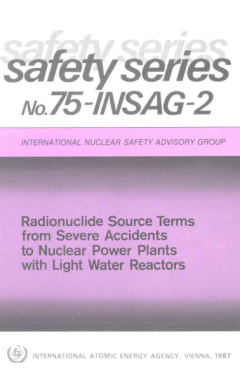
Safety Series No.75-INSAG-2 Radionuclide Source Terms From Severe Accidents t…
Nuclear power plants of the light water reactor (LWR) type are so designed and operated that no accident reasonably considered to be possible would release significant amounts of fission products to the environment. It follows that rare improbable events such as severe accidents would provide the only potentially significant contribution to adverse human health effects. The potential for such s…
- Edisi
- -
- ISBN/ISSN
- -
- Deskripsi Fisik
- -
- Judul Seri
- -
- No. Panggil
- -
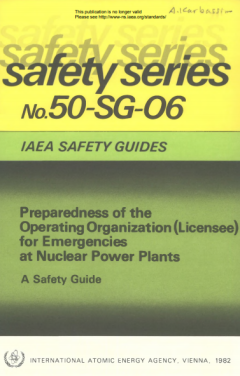
IAEA Safety Guides.Safety Series No.50-SG-06.Preparedness of the Operating Or…
This Safety Guide was prepared as part of the Agency’s programme, referred to as the NUSS programme, for establishing Codes o f Practice and Safety Guides relating to nuclear power plants. It supplements the Code of Practice on Safety in Nuclear Power Plant Operation, including Commissioning and Decommissioning (IAEA Safety Series No. 50-C-0), hereinafter referred to as the Code. The Provisio…
- Edisi
- -
- ISBN/ISSN
- -
- Deskripsi Fisik
- -
- Judul Seri
- -
- No. Panggil
- -
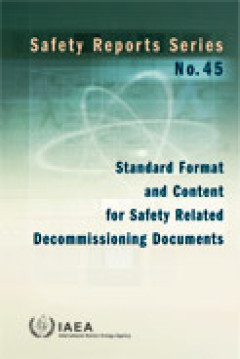
Standards Format and Content for Safety Related Decommisioning Document
This report provides information on the content and format for decommissioning plans and supporting safety related documents. Its scope includes information that is relevant to all types of nuclear facilities, ranging from nuclear power plants and reprocessing facilities to university laboratories and manufacturing plants. The report will be of interest to decommissioning planning engineers, pr…
- Edisi
- -
- ISBN/ISSN
- -
- Deskripsi Fisik
- 64 p. : Illus. ; 24 cm
- Judul Seri
- Safety Reports Series No. 45
- No. Panggil
- -
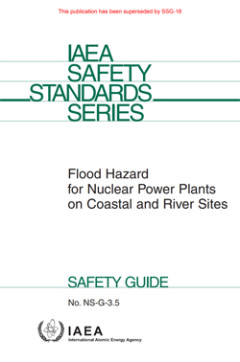
Flood Hazard for Nuclear Power Plants on Coastal and River Sites
This Safety Guide discusses the phenomena, both natural and human induced, that may cause floods or droughts at coastal and river sites, and gives an outline of the methods that can be used for, and the critical factors involved in, the evaluation of such events and of their associated effects. Possible combinations of two or more phenomena that can give rise to flooding at a site are also disc…
- Edisi
- -
- ISBN/ISSN
- -
- Deskripsi Fisik
- 83 p. : illus. ; 29,5 cm
- Judul Seri
- Safety Standards Series No. NS-G-3.5
- No. Panggil
- 621.48 IAE f
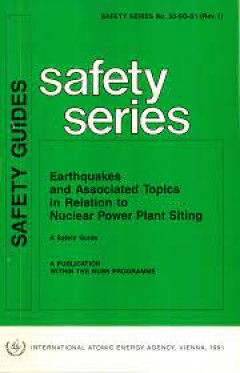
Earthquakes And Associated Topics In Relation To Nuclear Power Plants Siting,…
This Safety Guide was prepared as part of the Agency's programme for establishing Codes and Safety Guides relating to nuclear power plants. The main purpose of the text is to provide guidance on the determination of the design basis ground motions for a nuclear power plant at a chosen site and on the determination of the potential for surface faulting at that site. Additionally, the Guide discu…
- Edisi
- -
- ISBN/ISSN
- -
- Deskripsi Fisik
- 60 p. : illus. ; 24 cm
- Judul Seri
- Safety Series No. 50-SG-S1 (Rev.1)
- No. Panggil
- -
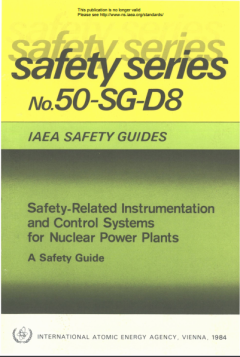
Safety-Related Instrumentation and Control System For Nuclear Power Plants
The systems which perform the vitai functions of monitoring and controlling systems and parameters at nuclear power plants are known as instrumentation and control (I&C) systems*. They are divided into two types: information systems and control systems. Both types operate by providing signals from measuring equipment. Information systems monitor plant parameters and systems; they display and…
- Edisi
- -
- ISBN/ISSN
- -
- Deskripsi Fisik
- -
- Judul Seri
- Safety Series No. 50-SG-D8
- No. Panggil
- 621.48 IAE s
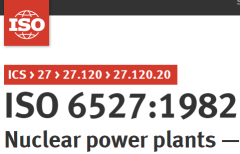
Nuclear Power Plants-Reliability data Exchange-General Guidlines
Identifies the typical parameters of a component that permit it to be characterized unequivocally and to allow the corresponding reliability data to be associated with those of other components having equivalent typical parameters. Parameters refer to technical characteristics including the physical principle of operation and quality level and to actual operating conditions and maintenance and …
- Edisi
- -
- ISBN/ISSN
- -
- Deskripsi Fisik
- -
- Judul Seri
- ISO 6527-1982 (E)
- No. Panggil
- -

Operating Limits and Conditions and Operational Limits Procedures for Nuclear…
This Safety Guide provides guidance on the development, content and use of operational limits and conditions (limits on plant operating parameters) and operating procedures that affect them. It recommends how to meet the requirements established in Safety Standards Series No. NS-R-2, Safety of Nuclear Power Plants: Operation, setting out the responsibilities of the operating organization in set…
- Edisi
- -
- ISBN/ISSN
- -
- Deskripsi Fisik
- 52 p. : Illus. ; 24 cm
- Judul Seri
- Safety Standards Series No. NS-G-2.2
- No. Panggil
- 621.48 IAE d
 Karya Umum
Karya Umum  Filsafat
Filsafat  Agama
Agama  Ilmu-ilmu Sosial
Ilmu-ilmu Sosial  Bahasa
Bahasa  Ilmu-ilmu Murni
Ilmu-ilmu Murni  Ilmu-ilmu Terapan
Ilmu-ilmu Terapan  Kesenian, Hiburan, dan Olahraga
Kesenian, Hiburan, dan Olahraga  Kesusastraan
Kesusastraan  Geografi dan Sejarah
Geografi dan Sejarah